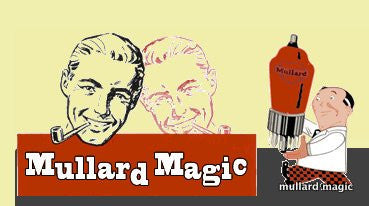THE GREAT MULLARD MAGIC BLOG — mullard
MULLARD FACTORY DYNAMIC VALVE TESTING
Posted by STEVE M on
Valves as we know, have many different functions and for each application there are certain parameters which ensure the best use in these applications, for example: - For an audio amplifier - knowledge of the maximal power output and distortion of an output valve for various levels of signal input under variable anode load resistance and grid load resistance is important. For a radio receiver - knowledge of the cross-modulation factor allows effective choice of frequency changer valves and IF amplifier valves so that effective AGC circuits may be designed. In order to measure these parameters and others such as equivalent noise resistance, hum level, conversion...
- Tags: MULLARD, VALVE TESTING
MULLARD FACTORY PRODUCTION VALVE TESTING
Posted by STEVE MYCIUNKA on
The Mullard valve factories had numerous test schedules for valves produced but today, we are going to look at the production test that EVERY valve that went into stock received which was known colloquially throughout the Mullard organisation at ' Test I'. It is interesting to note that, with the exception of the knock test, the test schedule is identical to that used by Mullard Magic before any of our valves go on sale. The Test I schedule was conducted by two girls, however, by mid 1953, for some popular valve types, Test I was automated meaning that...
- Tags: MULLARD, VALVE TESTING
NEW FOR 1953 - MULLARD VALVES FOR AUDIO AMPLIFIERS
Posted by STEVE M on
In late 1952, a new range of Mullard B9A Noval based valves having 6.3V heaters were introduced aimed at use in audio amplifiers. PRE-AMPLIFIER - type EF86 now replaced the EF37A or EF40 having similar charcteristics to the EF40 with a gain of up to 140 being achievable. The heater of the EF86 is rated at 6.3V @ 200mA. DOUBLE-TRIODES - three new devices were made available - the ECC81 being a medium impedance valve, the ECC82 a low impedance and the ECC83 a high impedance. All designs have independant cathodes for each section, centre tapped and capable of operation...
NEW FOR 1953 A LOW HUM LOW-MICROPHONY PENTODE - THE EF86 -
Posted by STEVE MYCIUNKA on
The EF86 audio frequency pentode had been designed for use in high grade resistance coupled AF voltage amplification circuits. - yes, this pentode was NOT designed as a TV valve as some ill informed naysayers would have you believe. In such circuits any hum and microphony introduced by the valve must be kept to a minimum and the EF86 shows a maximal hum level of 5uV referred to the control grid. This was achieved by using a bi-filar heater winding and careful internal screening, what, you thought that pin mesh screen was just for looks, oh no! What's that I...
- Tags: EF86, MESH ANODE, MULLARD, PENTODE
MULLARD VALVE ETCHED CODES - HOW TO INTERPRET THEM
Posted by STEVE M on
There is much conflicting fokelore on the internet about the Mullard etched valve codes so I thought I would add our two penny-worth. The etched codes have value to us today as they contain two discrete nuggets of information; firstly, should a valve loose it's printing you can identify the valve type and secondly, you can glean the production site and the month and year of manufacture. The etched codes, in general, comprise of two lines stacked vertically with the top line being a three character Engineering Code with the third digit signifying the development iteration of the valve. For example,...






